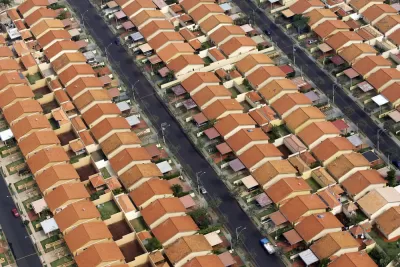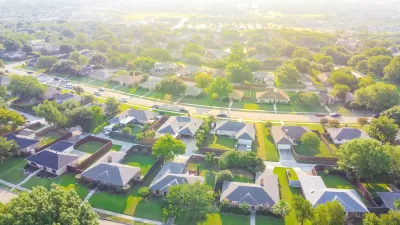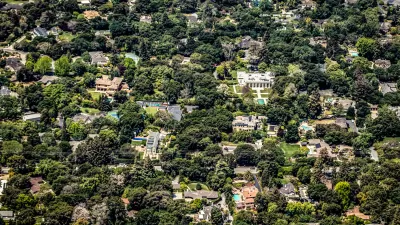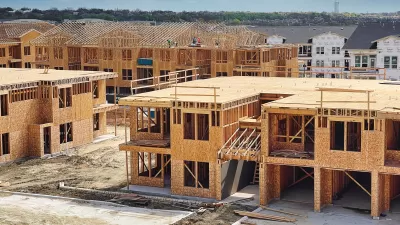Low-density zoning is not racist in the narrowest sense of the term—but it does have similar goals to racist housing policies and creates similar problems.

Is zoning racist? After a committee designed to study Seattle's zoning codes suggested some significant reforms to the city's code, Mayor Ed Murray said: "In Seattle, we’re also dealing with a pretty horrific history of zoning based on race, and there’s residue of that still in place." Even if this remark is factually true, it doesn't mean that today's zoning is racist: low-density zoning exists in black neighborhoods as well as white ones, and opposition to changing such zoning crosses color lines.
But it seems to me that even though zoning is not consistently or intentionally racist, zoning is similar to racist housing discrimination (or "RHD" for short) in a few ways. Both involve a politically influential dominant class (in one case, whites generally; in the other case, homeowners of all colors) who have the votes to impose their will on the political process. In both situations, the dominators use their political power to exclude someone else from its neighborhood; racists usually seek to exclude blacks, while pro-zoning homeowners usually seek to exclude new residents regardless of color (to the extent that zoning is designed to exclude housing smaller or more compact than the status quo, such as smaller houses or multifamily dwellings).*
Both RHD and low-density zoning do, on balance, exclude blacks more than whites—though of course RHD does so much more consistently. One purpose of zoning is to raise housing prices (or, as courts and homeowners euphemistically say, "values"). And higher housing prices mean higher rents, which means that everyone has to pay more for less. If you don't have any money, you are obviously going to suffer more from that policy than someone who has plenty of money, since the difference between having a small apartment and sleeping on the street is a bit more significant than the difference between having a 8000-square-foot mansion and a 12,000-square-foot mansion. And since blacks tend to have less money than whites, on balance blacks are going to suffer a little more than whites from these policies, just as they are going to suffer more from any tax imposed without ability to pay (for example, an increase in bus fares).**
RHD and low-density zoning are motivated by the same concern: fear of change in neighborhood character. Homeowners believe that new housing will change neighborhood character—and even if such housing does not have any tangible negative impact, this of course is the case. A neighborhood with ten houses per acre obviously looks and feels different than a neighborhood with one house per acre.
I suspect that racists similarly believe that an influx of blacks into their neighborhood will lead to crime, poor schools, and of course lower property prices—but even if they didn't believe this, racists might believe that a neighborhood where they have to look at black faces on a regular basis has a different character from one where they don't. Certainly, other forms of illegal discrimination affect neighborhood character: for example, a neighborhood full of Orthodox Jews has a very different character than an equally affluent neighborhood that does not, in that stores will be closed on the Jewish Sabbath and restaurants will comply with traditional Jewish dietary laws.
More importantly, both RHD and low-density zoning are rational for an individual neighborhood but perhaps irrational for a city, region or nation as a whole. A racist in the pre-Fair Housing era no doubt wanted to live in an all-white neighborhood, and even non-racist homeowners might have rationally favored RHD because they did not want to take a chance that integration would lead to unwelcome change. But the widespread adoption of fair housing legislation suggests that many whites did not welcome the nationwide results of rigid segregation.
Low-density zoning is more clearly rational for an individual neighborhood. After all, what homeowner would not like his home to be worth a little more, and what homeowner really wants his neighborhood to change (even in intangible ways)? But if no one liberalizes their zoning enough to accommodate new residents, rents explode, and a city's prospective residents are either priced out of the city or forced to live on the streets.
So what? Why should we care about these similarities? It seems to me that if RHD and zoning have similar results, maybe they should be attacked with similar remedies. RHD was not eliminated by allowing neighborhoods to discriminate a tiny bit less than they had discriminated in the past or by requiring only a few neighborhoods to cease discrimination. Instead, Congress and state legislatures responded with a meat ax: the Fair Housing Act generally prohibits housing discrimination, and has only a few narrow exemptions. Maybe state legislatures in high-cost states should use a similar meat ax in addressing zoning.
*As opposed to commercial and industrial enterprises, or houses larger than the neighborhood norm.
**On the other hand, to the extent that higher home prices increase property tax revenue, and property tax revenue means better government services, poorer people (and thus blacks) may get a countervailing benefit from better government services—if the extra revenue goes to services that disproportionately benefit the poor (a very big IF).

Alabama: Trump Terminates Settlements for Black Communities Harmed By Raw Sewage
Trump deemed the landmark civil rights agreement “illegal DEI and environmental justice policy.”

Study: Maui’s Plan to Convert Vacation Rentals to Long-Term Housing Could Cause Nearly $1 Billion Economic Loss
The plan would reduce visitor accommodation by 25% resulting in 1,900 jobs lost.

Planetizen Federal Action Tracker
A weekly monitor of how Trump’s orders and actions are impacting planners and planning in America.

Federal Homelessness Agency Places Entire Staff on Leave
The U.S. Interagency Council on Homelessness is the only federal agency dedicated to preventing and ending homelessness.

Restoring Northern India’s Himalayan ‘Water Temples’
Thousands of centuries-old buildings protect the region’s natural springs and serve as community wells and gathering places.

Milwaukee to Double Bike Share Stations
Bublr Bikes, one of the nation’s most successful, will add 500 new e-bikes to its system.
Urban Design for Planners 1: Software Tools
This six-course series explores essential urban design concepts using open source software and equips planners with the tools they need to participate fully in the urban design process.
Planning for Universal Design
Learn the tools for implementing Universal Design in planning regulations.
Caltrans
Smith Gee Studio
Institute for Housing and Urban Development Studies (IHS)
City of Grandview
Harvard GSD Executive Education
Toledo-Lucas County Plan Commissions
Salt Lake City
NYU Wagner Graduate School of Public Service






























